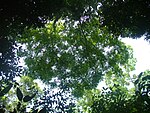Portal:Plants/Selected article/19
Simarouba amara is a dioecious species of tree in the Simaroubaceae family, found in the rainforests and savannahs of South and Central America and the Caribbean. It was first described by Aublet in French Guiana in 1775 and is one of six species of Simarouba. The tree is evergreen, but produces a new set of leaves once a year. It requires relatively high levels of light to grow and grows rapidly in these conditions, but lives for a relatively short time. The small yellow flowers are thought to be pollinated by insects, the resulting fruits are dispersed by animals including monkeys, birds and fruit-eating bats and the seeds are also dispersed by leaf cutter ants.
The leaves of S. amara are eaten by several species of caterpillar, particularly those in the Atteva genus. Several species of termite and ants live on or around the tree and lianas and epiphytes grow on the tree. The bark of S. amara has been used by people in its range to treat dysentery and diarrhea, as well as other diseases, and was also exported to Europe in the eighteenth century to treat these illnesses. A number of compounds have since been isolated from the bark and have been shown to have antimicrobial effects. Local people use the wood of the tree for various purposes and it is also grown in plantations and harvested for its timber, some of which is exported.

